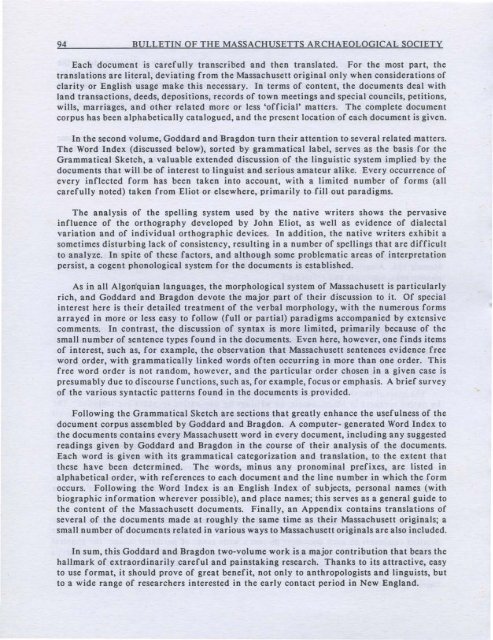No. 2 – October 1990
No. 2 – October 1990
No. 2 – October 1990
Create successful ePaper yourself
Turn your PDF publications into a flip-book with our unique Google optimized e-Paper software.
94 BULLETIN OF THE MASSACHUSETTS ARCHAEOLOGICAL SOCIETY<br />
Each document is carefully transcribed and then translated. For the most part, the<br />
translations are literal, deviating from the Massachusett original only when considerations of<br />
clarity or English usage make this necessary. In terms of content, the documents deal with<br />
land transactions, deeds, depositions, records of town meetings and special councils, petitions,<br />
wills, marriages, and other related more or less 'official' matters. The complete document<br />
corpus has been alphabetically catalogued, and the present location of each document is given.<br />
In the second volume, Goddard and Bragdon turn their attention to several related matters.<br />
The Word Index (discussed below), sorted by grammatical label, serves as the basis for the<br />
Grammatical Sketch, a valuable extended discussion of the linguistic system implied by the<br />
documents that will be of interest to linguist and serious amateur alike. Every occurrence of<br />
every inflected form has been taken into account, with a limited number of forms (all<br />
carefully noted) taken from Eliot or elsewhere, primarily to fill out paradigms.<br />
The analysis of the spelling system used by the native writers shows the pervasive<br />
influence of the orthography developed by John Eliot, as well as evidence of dialectal<br />
variation and of individual orthographic devices. In addition, the native writers exhibit a<br />
sometimes disturbing lack of consistency, resulting in a number of spellings that are difficult<br />
to analyze. In spite of these factors, and although some problematic areas of interpretation<br />
persist, a cogent phonological system for the documents is established.<br />
As in all Algonquian languages, the morphological system of Massachusett is particularly<br />
rich, and Goddard and Bragdon devote the major part of their discussion to it. Of special<br />
interest here is their detailed treatment of the verbal morphology, with the numerous forms<br />
arrayed in more or less easy to follow (full or partial) paradigms accompanied by extensive<br />
comments. In contrast, the discussion of syntax is more limited, primarily because of the<br />
small number of sentence types found in the documents. Even here, however, one finds items<br />
of interest, such as, for example, the observation that Massachusett sentences evidence free<br />
word order, with grammatically linked words often occurring in more than one order. This<br />
free word order is not random, however, and the particular order chosen in a given case is<br />
presumably due to discourse functions, such as, for example, focus or emphasis. A brief survey<br />
of the various syntactic patterns found in the documents is provided.<br />
Following the Grammatical Sketch are sections that greatly enhance the usefulness of the<br />
document corpus assembled by Goddard and Bragdon. A computer- generated Word Index to<br />
the documents contains every Massachusett word in every document, including any suggested<br />
readings given by Goddard and Bragdon in the course of their analysis of the documents.<br />
Each word is given with its grammatical categorization and translation, to the extent that<br />
these have been determined. The words, minus any pronominal prefixes, are listed in<br />
alphabetical order, with references to each document and the line number in which the form<br />
occurs. Following the Word Index is an English Index of subjects, personal names (with<br />
biographic information wherever possible), and place names; this serves as a general guide to<br />
the content of the Massachusett documents. Finally, an Appendix contains translations of<br />
several of the documents made at roughly the same time as their Massachusett originals; a<br />
small number of documents related in various ways to Massachusett originals are also included.<br />
In sum, this Goddard and Bragdon two-volume work is a major contribution that bears the<br />
hallmark of extraordinarily careful and painstaking research. Thanks to its attractive, easy<br />
to use format, it should prove of great benefit, not only to anthropologists and linguists, but<br />
to a wide range of researchers interested in the early contact period in New England.
















